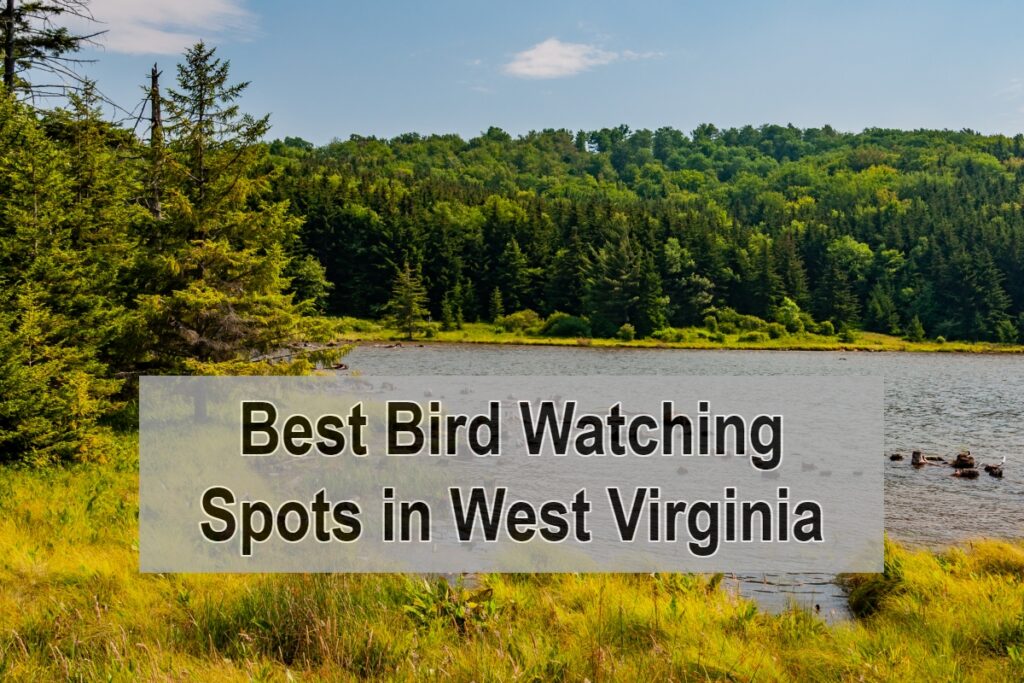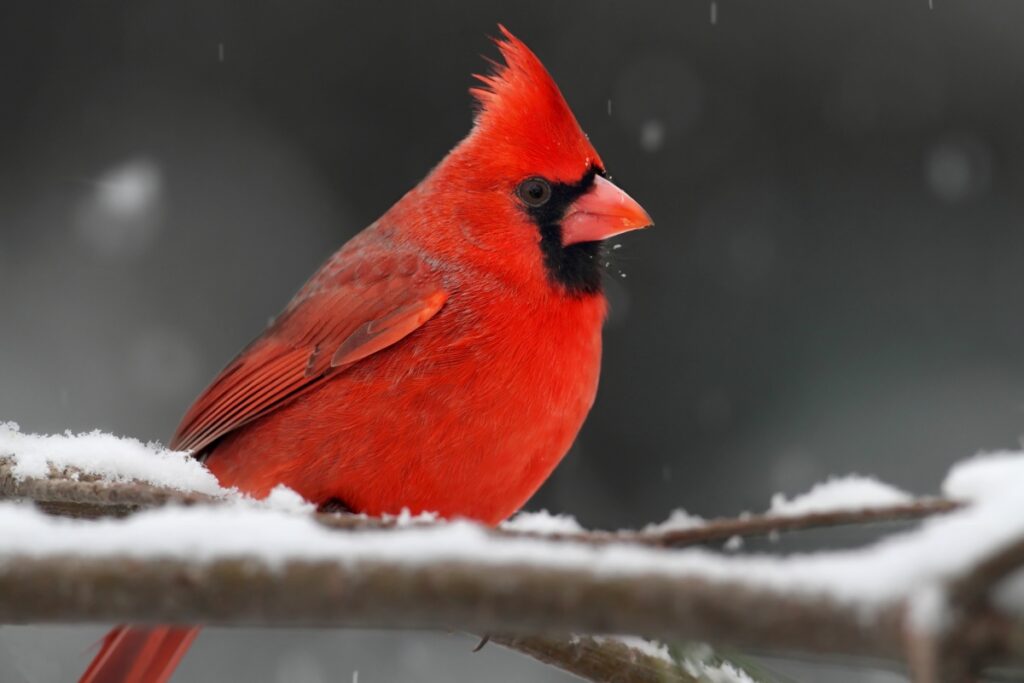As an Amazon Associate, we earn from qualifying purchases with no additional costs for you.
West Virginia is one of the smaller states at 62 259 km² in area. Despite this, a state is still a good place for birds. Knowing which spots are the best for birds is challenging, so I compiled this list of the best places to go to bird watch in West Virginia.
The best bird watching spots in West Virginia include the marshy areas of the Green Bottom Wildlife Management area and places with lakes and woodlands, such as Beech Fork and Clinton F. McClintic Area. The higher elevation at Gaudineer Scenic Area is also suitable for birdlife.
A table giving the most exciting birds you can see at each of my top 12 birding spots in West Virginia:
| PARK | INTERESTING BIRDS YOU CAN SEE |
|---|---|
| Clinton F. McClintic Wildlife Management Area | Red-shouldered Hawk and Cerulean Warbler |
| Green Bottom Wildlife Management Area | Bald Eagle and Osprey |
| Cranberry Glades Botanical Area | Northern Waterthrush and Black-throated Blue Warbler |
| Beech Fork State Park | Kentucky Warbler and Scarlet Tanager |
| Robert C. Byrd Locks and Dam | Herring Gull and Cliff Swallow |
| Gaudineer Scenic Area | Red Crossbill and Ruffed Grouse |
| Canaan Valley National Wildlife Refuge | Blue-headed Vireo and Black-throated Green Warbler |
| Blackwater Falls State Park | Pine Siskin and Canada Warbler |
| Stauffer’s Marsh Nature Preserve | American Bittern and Virginia Rail |
| Core Arboretum | Black-and-white Warbler and Yellow-throated Vireo |
| Cranesville Swamp | Palm Warbler and Broad-winged Hawk |
| Dolly Sods Wilderness Area | Golden Eagle and Red-breasted Nuthatch |
Read more below to learn about my best bird watching locations in West Virginia. I also describe the types of bird species you can find in each of these sites.
TIP: If you want to check out the best pair of binoculars for bird watching, we recommend a pair of waterproof and fog-proof 8 x 42 binoculars like the Celestron – Outland X 8×42 Binoculars (Amazon link).
Best Places to Bird Watch in West Virginia
West Virginia is known for its mountains, but there are many more places to find birds. Various habitats, including wetlands, bogs, woodlands, forests, and mountains, provide foraging and nesting spots for birds.
1. Clinton F. McClintic Wildlife Management Area
This area is 3655 acres and includes habitats such as fields, ponds, and hardwood forests. You can see a variety of bird species here because of the different habitats. A refuge is also a good place during migration.
The forests are an excellent place to see Red-shouldered Hawks and warblers like the Cerulean Warbler: Yellow Warblers, Blue-winged Warblers, Hooded Warblers, and Yellow-throated Warblers nest in the refuge.
Cerulean Warblers are decreasing in numbers and are of great conservation concern, making this an essential shelter for the species.
Wood Ducks also nest in the area. Watching for other breeding species like the Scarlet Tanager and Wood Thrush would be best. You can find a complete checklist of the 232 bird species recorded in this wildlife management area.
TIP: Knowing how to spot the birds in your yard is key to enjoying visits from your winged friends as much as possible! The best sources are trusted books, I recommend using the following (Amazon links):
– National Geographic Field Guide to the Birds of North America
– National Audubon Society Birds of North America
2. Green Bottom Wildlife Management Area
Green Bottom Wildlife Management Area is a 1096-acre refuge along the Ohio River. This large marshy area is suitable for waterfowl and shorebirds, but these are not the only birds you can see in the refuge.
Some species that breed here and occur in the marsh, particularly in summer, include the following: Least Bittern, Sora, King Rail, and Virginia Rail. Least Bittern can be found outside of summer, but you should visit when most species are in the marsh if you hope to see the rails.
Wading birds seen in the refuge include the Great Blue Heron and Green Heron. Raptors in the park include American Kestrels, Ospreys, and Bald Eagles.
Black-and-white Warblers, Prothonotary Warblers, Orchard Orioles, Indigo Buntings, and Yellow Warblers have also been recorded in the trees and bushes found in the refuge.
3. Cranberry Glades Botanical Area
This is found in the Monongahela National Forest and includes a peat bog with a boardwalk so people can easily explore the area.
You can find flycatchers here, including the Willow Flycatcher and Alder Flycatcher. You can also see Wild Turkeys, Common Redpolls, and Eastern Towhees at Cranberry Glades.
Several warbler and songbird species have been recorded in the area, including the Magnolia Warbler, Veery, Northern Waterthrush, Black-throated Blue Warbler, Chestnut-sided Warbler, and Canada Warbler.
Other bird species in this area include Ruffed Grouse, Red Crossbill, and Pine Siskin.
4. Beech Fork State Park
Beech Fork State Park includes Beech Fork Lake. The Audubon Society has designated the park and lake as important bird areas.
The area is also good during the annual spring migration when you can see many birds in their breeding plumage.
Spring migrants are more accessible to identify than fall migrants since male birds will have their bright colors, making species recognition much more straightforward.
Many birds nest in the Beach Fork State Park Area, including Red-headed Woodpeckers and Broad-winged Hawks.
You can also find passerine species such as Kentucky Warbler, Black-and-white Warbler, Yellow-throated Warbler, and Hooded Warbler.
Louisiana Water-thrushes, Wood Thrushes, Ovenbirds, and Scarlet Tanagers have also been observed in the park’s wooded areas.
Some of these, like the Ovenbirds, are typically seen close to the ground, while Scarlet Tanagers are more commonly seen in the middle story higher up in the trees.
5. Robert C. Byrd Locks and Dam
Many birds are on and around the Ohio River in the fish hatchery ponds. Shorebirds are present where the water level is low and the muddy shore is exposed. You can find shorebirds like sandpipers and plovers foraging for food in these areas.
You can find the most shorebirds here in summer, especially in May. The most common gulls here are the Ring-billed Gulls and Herring Gulls.
Bird species that breed in the area include Grasshopper Sparrow, Yellow Warbler, Wood Duck, Blue Grosbeak, and Cliff Swallow.
6. Gaudineer Scenic Area
This is a 140-acre spruce forest that forms part of the Monongahela National Forest. Besides the woods, there is also Gaudineer Knob, the summit (at 4,449 ft) of Shaver’s Mountain.
Various species can be found at Gaudineer Scenic Area, including the following: Yellow-rumped Warbler, Purple Finch, Dark-eyed Junco, Black-throated Green Warbler, and Canada Warbler.
You can also find higher-elevation species like the Common Raven and Red Crossbill in this area. Red Crossbills are like coniferous forests. Common Ravens prefer higher elevations and can most often be found in coniferous forests near mountains.
At Gaudineer Scenic Area, you can find various wrens and thrushes, specifically, Winter Wrens, Wood Thrushes, and Hermit Thrushes.
Other birds in the area include the Olive-sided Flycatcher, Magnolia Warbler, Blackburnian Warbler, Veery, and Blue-headed Vireo. Ruffed Grouse are also found here, although they may be challenging to see.
7. Canaan Valley National Wildlife Refuge
This refuge is 16,550 acres and has a range of habitats, including open areas, wetlands, and forests. Trails near the Blackwater River are very good for bird watching. You can contact the refuge to learn more about these trails and how to access various areas of the refuge.
You can see species of birds, such as Black-billed Cuckoo, Yellow-billed Cuckoo, and Alder Flycatcher. Of the two cuckoo species, the Black-billed Cuckoo is harder to see because it is more secretive.
Warblers and vireos to watch out for include Blue-headed Vireo, Black-throated Green Warbler, and Chestnut-sided Warbler. You can likely see Bobolinks and Savannah Sparrows. Swamp Sparrows you should search for in the vegetation of the wetlands.
8. Blackwater Falls State Park
This park is close to Canaan Valley, so it is worth a trip while you are in the general area. Birds here are similar to Canaan Valley State Park.
There are several hiking trails, waterfalls, overlooks, and lush vegetation. You can find out more about the trails here and what to expect.
You can see bird species like the Golden-crowned Kinglet, Blue-headed Vireo, Pine Siskin, and Canada Warbler.
You definitely should make a point of looking for the beautifully-colored Blackburnian and Magnolia Warblers in the trees.
The males of both species are bright in color and easy to identify if seen during the time of year (spring and summer) when they have their breeding plumage.
TOP TIP: Bird-watching is not the same all year round. To learn about how to get the best bird watching experience all year, take a look at this article. To help understand what birds eat in different seasons and how to attract them, check out this article .
9. Stauffer’s Marsh Nature Preserve
This refuge is located in the eastern part of West Virginia near Martinsburg. One hundred fifty bird species have been recorded here, making this a worthwhile spot for birding.
Bird species you can find here include the following: Least Bittern, Green Heron, Sora, Virginia Rail, and American Bittern. There have been occasional sightings of Bald Eagles and Osprey.
You can also find birds like Willow Flycatchers, Yellow-billed Cuckoos, Baltimore, and Orchard Orioles. These species also breed in the preserve.
10. Core Arboretum
The arboretum is situated on the banks of the Monongahela River. West Virginia University manages it.
There is an old-growth forest at the arboretum with various trees, including hickory trees, oaks, and willows. This area is a hotspot during spring migration, and the Audubon Society gives walks during this time.
Birds you can find here include the following species: Yellow-throated Warbler, Black-and-white Warbler, Yellow-throated Vireo, and Scarlet Tanager.
11. Cranesville Swamp
This swamp is located close to Maryland and is a peat bog. Cranesville Swamp is in the Appalachian Mountains, and the marsh has coniferous and hardwood forests. There are trails and a boardwalk traversing the wetland, which is convenient for bird watchers.
The area is cold and moist compared with many other sites. Because of this, you can find birds more often found in colder regions. There is a checklist available for the 164 species found here.
You can find bird species such as Veery, Hermit Thrush, Magnolia Warbler, Palm Warbler, Bay-breasted Warbler, Tree Swallow, and Broad-winged Hawk.
TIP: Check out my recommended products if you are looking for the best and trusted equipment for birdwatching in the wild or on your backyard (Amazon link):
- Celestron Outland X 8×42 Binoculars
- Celestron Ultima 80 Angled Spotting Scope
- National Audubon Society Birds of North America Book
- Design Free-standing Bird Bath
- Smart Bird Feeder with Camera
- Cedar Bird House for Outside
12. Dolly Sods Wilderness Area
This is a large wildlife area that is greater than 17,000 acres in size. This is situated in the Monongahela National Forest and is comprised of pine plantations, sphagnum bogs, forest patches of spruce, ash, and alder trees, and upland heaths.
There is an altitudinal change from about 2,500 feet to 4,700 feet, meaning a diversity of birds occur here. Sparrows to look out for in this wilderness area include the Vesper Sparrows and Savannah Sparrows.
Some birds you can find in the area include the following: American Crows, Red-breasted Nuthatches, White-breasted Nuthatches, Red-shouldered Hawks, Common Yellowthroats, Common Ravens, and Ruffed Grouse.
People have also spotted Bald Eagles, Golden Eagles, and Northern Harriers. There is even a record of a Merlin having been spotted in the region.
TOP TIP: Birds are a critical aspect of all ecosystems, and they know how to take care of one another. This article outlines how birds help spread berry seeds, and this article outlines how birds care for each other when they become injured.
Best Time to Bird Watch in West Virginia
You can see birds at any time of the year in West Virginia, but some species are more abundant in particular seasons.
| TYPES OF BIRDS | SEASON |
|---|---|
| Bald Eagles | Winter |
| Warblers | Spring and Summer |
The West Virginia State Bird
The Northern Cardinal was designated in 1949 as the state bird of West Virginia. The cardinal is an easily recognizable species that is also very vocal. They occur in semi-open brush areas and gardens.
The female is a drabber brown with some reddish tinge to the face. The male is bright red with some black on his face. The birds are seed-eaters but will also eat insects and will feed their chicks on insects for added protein.
Bird Watching Laws in West Virginia
In West Virginia, it is illegal to take or have in your possession any of the native species of birds and other wildlife. In addition, you need to have a state permit to be permitted to participate in bird banding.
My Favourite Equipment for Bird Watching
Bird watching is one of the least expensive hobbies out there, but you still need some equipment to get the most out of it.
The essential equipment to start bird watching is a pair of binoculars. My preference is 8 X 42 binoculars. The number 8 is how much the magnification is, while 42 is the field of view in millimeters of the lenses.
A pair of waterproof and fog-proof 8 x 42 binoculars like the Celestron – Outland X 8×42 Binoculars on Amazon is an excellent choice for both beginners and experts.
In time, you can choose more expensive models and also opt to buy a spotting scope like the Celestron Ultima 80 on Amazon.
These are a lot more expensive compared with binoculars though, so if you are only a beginner, start with binoculars first. A spotting scope is only helpful for birds far away, such as out on a pond or seashore.
There are a few rules or guidelines you should abide by as an ethical birder. These are listed below.
- Do not enter private lands without prior permission from landowners.
- Follow all the rules in refuges and reserves, including cleaning up any garbage from your campsite.
- Do not disturb birds on nests.
- Do not use apps and play songs to call up birds when they are hungry, tired, and breeding during spring and summer.
Conclusion
West Virginia provides many opportunities for bird watching, from lakes and marshes to forests and high-elevation spots.
The range of birds that move through the state on migration and that nest in the area means that there is always a good chance of seeing new and exciting bird species. I would recommend attending some or all of the spots I have discussed.
TIP: If you want to check out the best pair of binoculars for bird watching, we recommend a pair of waterproof and fog-proof 8 x 42 binoculars like the Celestron – Outland X 8×42 Binoculars (Amazon link).


